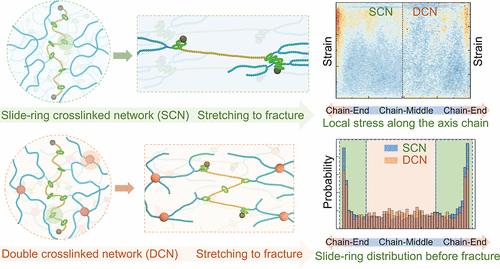Robust Artificial Spider Silk via Synergistic Cross-Linking of Slide-Ring and Covalent Bonds
IF 5.2
1区 化学
Q1 POLYMER SCIENCE
引用次数: 0
Abstract
Inspired by the structure of spider silk, the introduction of slide-ring molecules into covalent networks to construct double cross-linked networks (DCNs) has become an effective strategy for preparing robust polymer artificial spider silk. However, the complex interplay between the two cross-linking modes poses significant challenges for elucidating the molecular mechanisms underlying mechanical enhancement and hinders the precise design and fabrication of robust artificial silks. Here, we engineered robust artificial spider silk fibers based on DCNs and employed coarse-grained molecular dynamics (CGMD) simulations to establish quantitative models linking the network architecture to macroscopic mechanical properties. The models reveal that slide-ring-only networks suffer from ring aggregation and chain slippage under strain, which leads the multifolded axis chains to straighten and unfold, ultimately forming highly oriented structures. In contrast, DCNs utilize covalent anchors to regulate the ring mobility, stabilize multifolded chain structures, and balance energy dissipation with mechanical integrity. These molecular-level insights are supported by experiments. By tuning the slide-ring cross-linking fraction and introducing Zr4+ ions as dynamic supramolecular regulators, we achieved highly aligned nanofibers with both exceptional tensile strength (1.18 GPa) and toughness (135 MJ m–3). The synergy between dynamic and permanent cross-links enables efficient stress redistribution and crack resistance. This work provides inspiration for the design of high-performance fiber materials.

通过滑动环和共价键的协同交联实现坚固的人造蜘蛛丝
受蜘蛛丝结构的启发,将滑环分子引入共价网络中构建双交联网络(DCNs)已成为制备高强度高分子人造蜘蛛丝的有效策略。然而,两种交联模式之间复杂的相互作用对阐明机械增强的分子机制提出了重大挑战,并阻碍了精确设计和制造坚固的人造丝。在这里,我们基于DCNs设计了坚固的人造蜘蛛丝纤维,并采用粗粒度分子动力学(CGMD)模拟建立了将网络结构与宏观力学性能联系起来的定量模型。模型表明,纯滑环网络在应变作用下会发生环聚集和链滑移,从而导致多折叠轴链拉直和展开,最终形成高度定向的结构。相比之下,DCNs利用共价锚来调节环的迁移,稳定多折叠链结构,平衡能量耗散和机械完整性。这些分子水平的见解得到了实验的支持。通过调整滑环交联分数和引入Zr4+离子作为动态超分子调节剂,我们获得了高度排列的纳米纤维,具有优异的拉伸强度(1.18 GPa)和韧性(135 MJ m-3)。动态和永久交联之间的协同作用使有效的应力重新分布和抗裂。这项工作为高性能纤维材料的设计提供了灵感。
本文章由计算机程序翻译,如有差异,请以英文原文为准。
求助全文
约1分钟内获得全文
求助全文
来源期刊

Macromolecules
工程技术-高分子科学
CiteScore
9.30
自引率
16.40%
发文量
942
审稿时长
2 months
期刊介绍:
Macromolecules publishes original, fundamental, and impactful research on all aspects of polymer science. Topics of interest include synthesis (e.g., controlled polymerizations, polymerization catalysis, post polymerization modification, new monomer structures and polymer architectures, and polymerization mechanisms/kinetics analysis); phase behavior, thermodynamics, dynamic, and ordering/disordering phenomena (e.g., self-assembly, gelation, crystallization, solution/melt/solid-state characteristics); structure and properties (e.g., mechanical and rheological properties, surface/interfacial characteristics, electronic and transport properties); new state of the art characterization (e.g., spectroscopy, scattering, microscopy, rheology), simulation (e.g., Monte Carlo, molecular dynamics, multi-scale/coarse-grained modeling), and theoretical methods. Renewable/sustainable polymers, polymer networks, responsive polymers, electro-, magneto- and opto-active macromolecules, inorganic polymers, charge-transporting polymers (ion-containing, semiconducting, and conducting), nanostructured polymers, and polymer composites are also of interest. Typical papers published in Macromolecules showcase important and innovative concepts, experimental methods/observations, and theoretical/computational approaches that demonstrate a fundamental advance in the understanding of polymers.
 求助内容:
求助内容: 应助结果提醒方式:
应助结果提醒方式:


